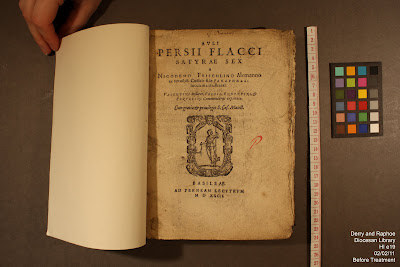De Politia Jv DIACA, shelf mark JI c7 (1574) is a full leather binding sewn on raised bands. On receipt the spine was severely damaged and the cords broken at back joint.
The textblock required some repair including, dry cleaning, relaxing creases, and paper repair. The parchment guard at the back of the book was removed, humidified, flattened and repaired then resewn to the textblock with a new handmade endpaper. Once all paper repairs were completed the book was given a Japanese paper lining to consolidate the textblock.
Once the textblock was stable a new point of attachment from the back board to the textblock was needed. To do this I used sewing thread sewn around the original cords and slowly built up enough thread to create a cord. These new cords were then laced through the original lacing holes.
With the board now securely attached a new toned leather reback was applied to the spine. The original leather was then adhered on top of the new spine leather and the cover boards. It should be noted that the original spine had a paper label on the second panel; this label was not reattached to the rebacked book as it extended onto the joints of the book. The label was however retained and boxed with the item.

Head after conservation
















































